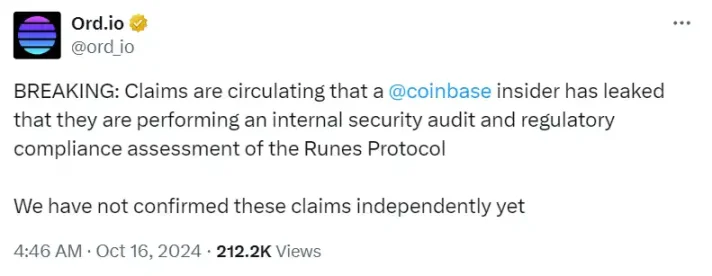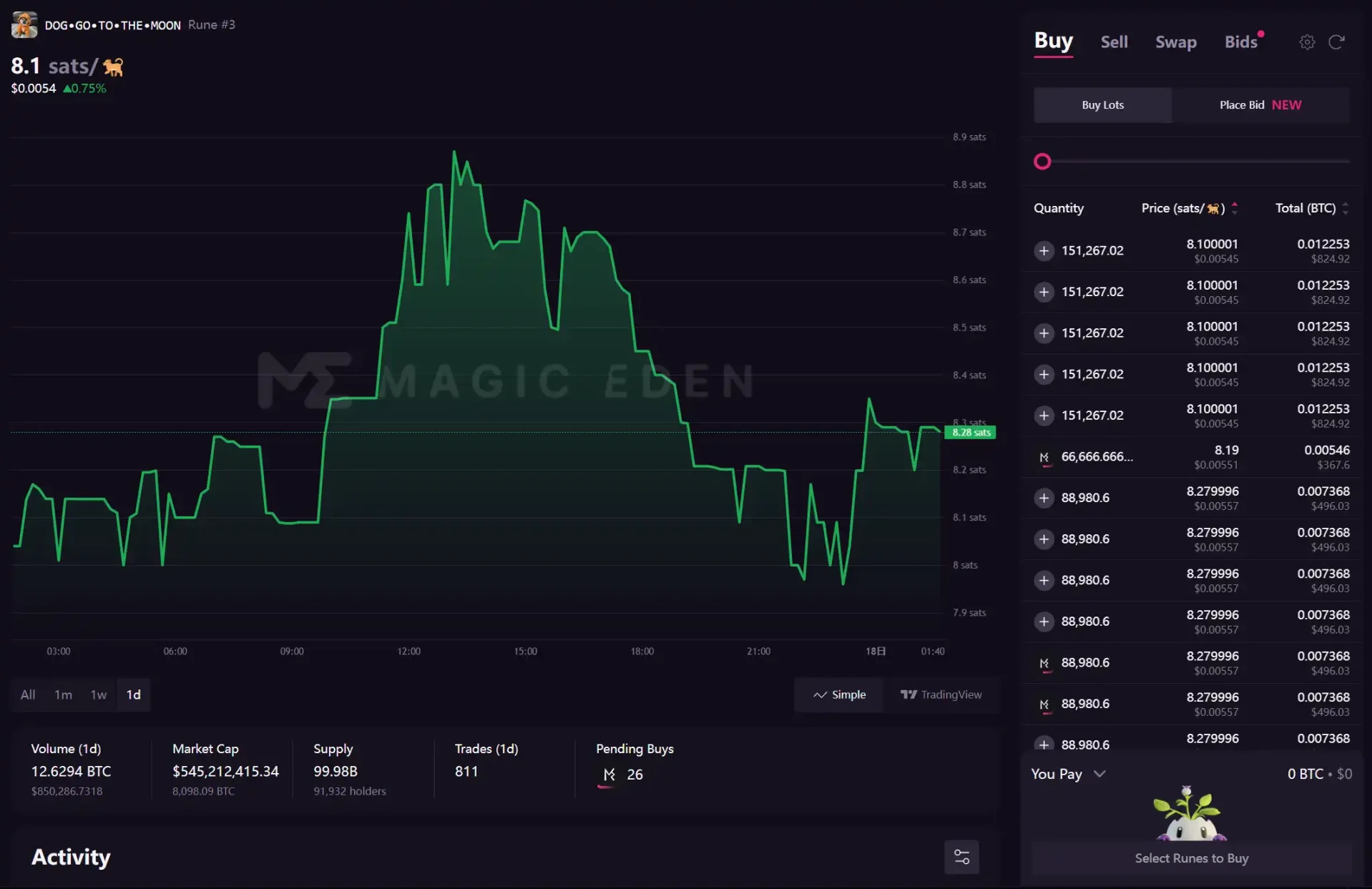Whether OP_CAT can be revived in this bull market will determine the direction of the Bitcoin ecosystem.
Written by: Cookie
The market is eagerly anticipating Bitcoin to break the $70,000 mark. For many players, if Bitcoin can break $70,000 and stabilize around this price point, the long-awaited bull market will officially begin.
In this optimistic atmosphere, important assets in the Bitcoin ecosystem have seen an increase. The BRC-20 token $ORDI has risen by as much as 25% in the past week, while $SATS has increased by up to 15%.
Even more exciting is the rune market, led by the new cat "Gizmo" released by Bitcoin Puppets artist @lepuppeteerfou on Twitter. The rune GIZMO•IMAGINARY•KITTEN skyrocketed to a peak market value of nearly $20 million after all were minted. Although @lepuppeteerfou denies any connection to the rune, market enthusiasm remains high.
The popularity of GIZMO•IMAGINARY•KITTEN has led to the emergence of two other "golden dogs": KODA•FLUFFINGTON, inspired by the dog of NodeMonkes founder, and POOKA•CANNOT•BE•STOPPED, inspired by the dog of suspected OMB founder zkshark. Both quickly surpassed the $1 million market cap, a challenging threshold in the rune market. KODA•FLUFFINGTON peaked at nearly $4 million, while POOKA•CANNOT•BE•STOPPED reached nearly $3 million.
Several leading assets in the rune market have also seen significant increases. PUPS•WORLD•PEACE and BILLION•DOLLAR•CAT have risen nearly 9 times since the end of September, while DOG•GO•TO•THE•MOON has increased by up to 1 time. Just yesterday, @ord_io tweeted that an insider from Coinbase revealed that Coinbase is conducting an internal security audit and regulatory compliance assessment for runes, although they have not independently confirmed these rumors. This has led many to speculate about the recent surge in rune prices.

If the bull market is about to begin, what kind of prospects can we see for the Bitcoin ecosystem?
On the eve of a major change, will we continue to be conservative or move towards openness?
The revival of OP_CAT on the Bitcoin mainnet is of great significance because the vision of "realizing smart contracts on the Bitcoin mainnet" is no longer a question of "can it be done," but rather a choice of "should it be done."
The popularity of the Ordinals protocol last year undoubtedly contributed significantly to the Bitcoin ecosystem's move towards openness, but it only opened a crack in the door. The consensus of the Ordinals protocol is merely a small subset of Bitcoin's consensus, and because of this, protocols like BRC-20 and runes on Bitcoin, in terms of user experience, are akin to NFTs that "can be infinitely fragmented," and can only be considered "subpar" compared to FT protocols on other chains.

The purchasing interface for runes on Magic Eden resembles an NFT without images.
Why is it said that the lack of functionality or user experience in the protocol is a problem of Bitcoin consensus? Because the lack of further openness in Bitcoin's consensus means that the restrictions on the Bitcoin mainnet remain numerous. Protocols like Ordinals, BRC-20, and runes can only find ways to achieve the goal of "issuing tokens/images on the Bitcoin mainnet" within these constraints. Even so, there are still opposing forces like Bitcoin Core developer Luke Dashjr, who believes these protocols are damaging to the Bitcoin mainnet and has consistently resisted these innovations.
If the BIP-347 proposal "OP_CAT in Tapscript" is passed and the Bitcoin mainnet ultimately completes a soft fork, it would mean a significant change in Bitcoin's consensus, shifting from conservative to open, and the narrative ceiling of Bitcoin would be reopened. The term "reopened" is used because I believe that runes have already taken the narrative of "issuing tokens on the Bitcoin mainnet" to its extreme, making it difficult for later entrants to shake its position unless it is through a disruptive innovation like smart contracts.
However, whether OPCAT can be revived in this bull market is highly uncertain. Being assigned a BIP proposal does not mean that the community has reached a consensus on a particular issue; it merely means "the community can start debating this." We may not even have reached the stage of considering "whether there is enough support," still being in the phase of "this topic needs more discussion." One of the blue-chip NFT projects in Bitcoin, Quantum Cats, is essentially a "campaign" for the OPCAT issue, with Udi Wertheimer acting as an active "politician" in Bitcoin, leading a blue-chip NFT community to rally for the revival of OP_CAT. Udi has repeatedly attempted to debate Luke Dashjr directly on Twitter Spaces, but Luke often adopts an "I don't care" attitude, which suppresses the supporters.
If OPCAT can successfully revive in this bull market, the technical narrative on the Bitcoin ecosystem will almost certainly be guided by OPCAT. Currently, the attempts to promote the revival of OP_CAT include Quantum Cats and the CAT20 protocol on Fractal.
If it cannot, then runes are likely to maintain their position as the most influential FT protocol in the Bitcoin ecosystem.
The rune market needs to undergo more tests
A rune only truly becomes an FT after being listed on a CEX. Before that, the nature of runes is not much different from NFTs, which is reflected in their market value, exhibiting significant "backlash"—when liquidity is good, the market value skyrockets, but conversely, it can plummet, with a bunch of small fragmented orders stuck near the floor price, leading to lower-priced sell orders and creating a dead cycle of no interest.
The true market value of a rune needs to be tested through liquidity on a CEX, which may also be one reason why the listing of rune tokens on CEXs is very slow.
In addition to CEXs, there are rune swap products like Dotswap on the Bitcoin mainnet, and Magic Eden is also about to launch a rune swap feature. An interesting phenomenon is that while Dotswap's rune swap product is good, it has not attracted enough traffic; instead, CAT20 on Fractal has brought considerable attention to Dotswap. It remains to be seen whether Magic Eden can improve the on-chain liquidity of runes with its own traffic and excellent user experience.
In terms of the richness of tokens, runes already have "Cult tokens" like PUPS•WORLD•PEACE, but the hot topics are still relatively thin, currently revolving around a few major NFT projects or simply based on the size of the holder community. More players need to enter to create a better environment for content and the formation of Cult tokens. This is also reflected in PUPS•WORLD•PEACE and BILLION•DOLLAR•CAT bridging to Solana for greater breakthroughs.
As for the prospects of BRC-20, they currently appear somewhat dim, with $ORDI, $SATS, and $PIZZA being almost the entirety of BRC-20.
The NFT blue-chip tier is relatively stable, and there is still room for exploration in narrative uniqueness
NodeMonkes, Bitcoin Puppets, OMB (Ordinal Maxi Biz), Quantum Cats, and Pizza Ninjas have solidified their blue-chip status. Additionally, Bitcoin Shrooms is a relatively unique presence, with a very low total supply and a minting number very close to the beginning, but its floor price remains stable above 1 BTC.
In the realm of purely artistic NFTs, since generative art has become somewhat "yesterday's news" on Ethereum, art on Bitcoin needs to seek breakthroughs in themes, such as concept art that combines Bitcoin's cultural attributes or AI art. From this perspective, CENTS may be the most unique art series currently on Bitcoin, with its uniqueness being that "this flavor cannot be replicated on other chains."
The artist behind CENTS is Rutherford Chang, who selected pennies minted in copper from 1982 and earlier from hundreds of thousands of pennies (in 1982, the material of pennies changed from copper to zinc due to cost reasons). In addition to being inscribed on Bitcoin, the physical pennies were melted into a complete copper block.
Bitcoin allows CENTS to form a kind of "entanglement of value":
- You cannot distinguish whether this is a 1 cent inscribed on Bitcoin or a 1 satoshi inscribed on a penny.
- The artificial scarcity of pennies and Bitcoin's "scarcity" are intertwined. All 1 cent coins in the CENTS series are old pennies made of 95% copper and 5% zinc, minted in 1982 or earlier, which are effectively no longer being produced. Meanwhile, the amount of Bitcoin available for inscription has also decreased by 1 satoshi.
- The legal value of a 1 cent coin is 1 cent, but the production cost of minting a 1 cent coin is higher than 1 cent, and the value of 1 satoshi is less than 1 cent. These 10,000 1 cent coins have clearly been transferred to a currently lower-priced medium of value, yet they reflect a higher value. Currently, the price of 1 CENTS is about $330, while the auction price of the physical copper block in June was $50,400, and the legal value of 10,000 1 cent coins is $100.
- As time passes, the legal value of 1 cent coins may one day cease to exist, the production cost of minting a 1 cent coin may continue to fluctuate, and the value of 1 satoshi may far exceed 1 cent.
Such a narrative cannot be replicated on other chains because the coins on other chains do not evoke the same sense of being a real coin or currency as Bitcoin does.
The DMT concept is also a noteworthy unique artistic narrative in Bitcoin. In short, there are many types of data on the Bitcoin blockchain, such as block hash values, block sizes, block heights, block target difficulties, etc. Creating specific digital assets based on this data is the goal that DMT hopes to achieve. Currently, aside from the leading project Natcats, no other projects have garnered enough market attention in the DMT concept.
Conclusion
Whether OPCAT can be revived in this bull market will determine the direction of the Bitcoin ecosystem. Some directions that have not yet become market hotspots, such as the Lightning Network (Taro, RGB, CKB) and BitVM, may gain more attention if OPCAT fails to revive.
The Bitcoin ecosystem is currently the only place in the crypto market where "technical narratives" can still run smoothly. The reason is simple—Bitcoin is like an old computer still running on a Pentium 4 processor, with enough hardware to update it; it just depends on whether the data center administrators can reach a consensus. But forming a consensus is incredibly difficult; it involves not only clashes of ideas but also real-world interests.
Nevertheless, the Bitcoin ecosystem will undoubtedly be one of the important narratives in this bull market, and it will be a particularly unique presence compared to other ecosystems.
免责声明:本文章仅代表作者个人观点,不代表本平台的立场和观点。本文章仅供信息分享,不构成对任何人的任何投资建议。用户与作者之间的任何争议,与本平台无关。如网页中刊载的文章或图片涉及侵权,请提供相关的权利证明和身份证明发送邮件到support@aicoin.com,本平台相关工作人员将会进行核查。




